NPV Analysis of Truck Project: An Advanced Corporate Finance Report
VerifiedAdded on 2023/04/21
|6
|991
|247
Report
AI Summary
This report provides a comprehensive evaluation of a proposed acquisition of a special-purpose truck, as requested by the company's president. It includes a detailed calculation of the net investment in the truck project, considering the purchase cost, special modification costs, increase in net working capital, and non-cash depreciation using the MACRS method. The report also calculates the operating cash flows for years 1 and 2, factoring in depreciation expenses, labor cost savings, and changes in working capital. Finally, the Net Present Value (NPV) of the truck project is determined using a discount rate of 9%, leading to a recommendation to accept the project based on its positive NPV of $93,811.55. Desklib provides access to similar solved assignments and past papers for students.
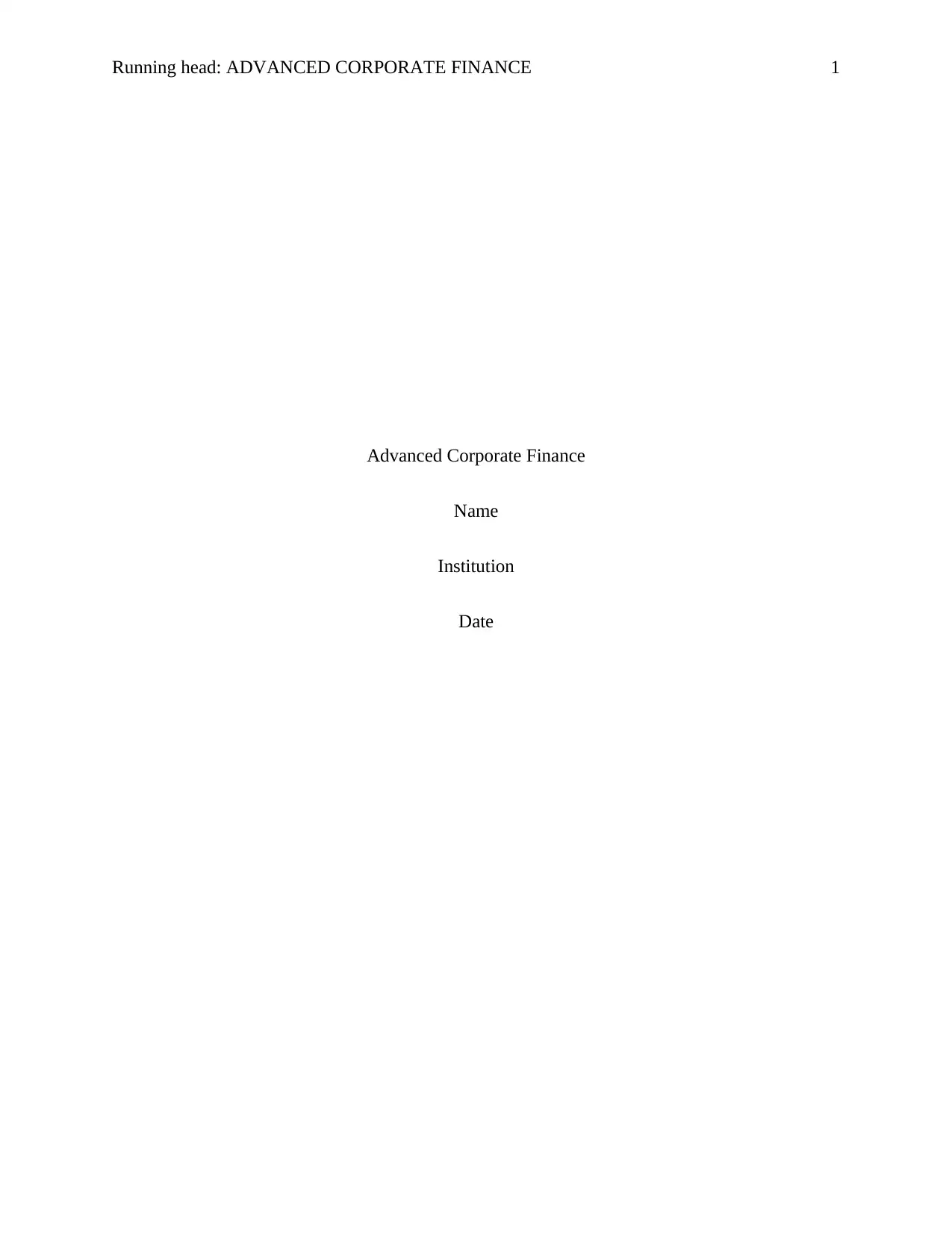
Running head: ADVANCED CORPORATE FINANCE 1
Advanced Corporate Finance
Name
Institution
Date
Advanced Corporate Finance
Name
Institution
Date
Paraphrase This Document
Need a fresh take? Get an instant paraphrase of this document with our AI Paraphraser
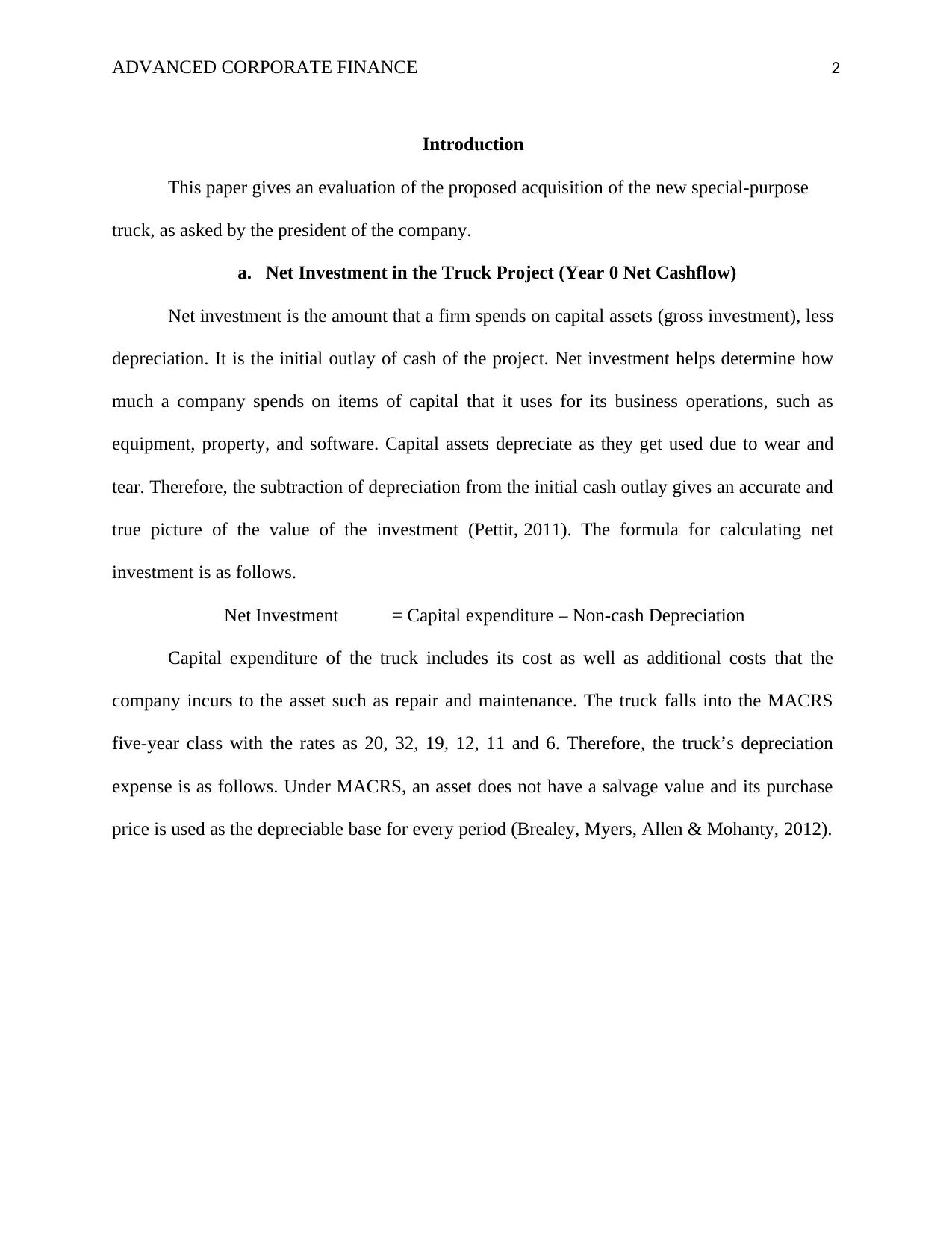
ADVANCED CORPORATE FINANCE 2
Introduction
This paper gives an evaluation of the proposed acquisition of the new special-purpose
truck, as asked by the president of the company.
a. Net Investment in the Truck Project (Year 0 Net Cashflow)
Net investment is the amount that a firm spends on capital assets (gross investment), less
depreciation. It is the initial outlay of cash of the project. Net investment helps determine how
much a company spends on items of capital that it uses for its business operations, such as
equipment, property, and software. Capital assets depreciate as they get used due to wear and
tear. Therefore, the subtraction of depreciation from the initial cash outlay gives an accurate and
true picture of the value of the investment (Pettit, 2011). The formula for calculating net
investment is as follows.
Net Investment = Capital expenditure – Non-cash Depreciation
Capital expenditure of the truck includes its cost as well as additional costs that the
company incurs to the asset such as repair and maintenance. The truck falls into the MACRS
five-year class with the rates as 20, 32, 19, 12, 11 and 6. Therefore, the truck’s depreciation
expense is as follows. Under MACRS, an asset does not have a salvage value and its purchase
price is used as the depreciable base for every period (Brealey, Myers, Allen & Mohanty, 2012).
Introduction
This paper gives an evaluation of the proposed acquisition of the new special-purpose
truck, as asked by the president of the company.
a. Net Investment in the Truck Project (Year 0 Net Cashflow)
Net investment is the amount that a firm spends on capital assets (gross investment), less
depreciation. It is the initial outlay of cash of the project. Net investment helps determine how
much a company spends on items of capital that it uses for its business operations, such as
equipment, property, and software. Capital assets depreciate as they get used due to wear and
tear. Therefore, the subtraction of depreciation from the initial cash outlay gives an accurate and
true picture of the value of the investment (Pettit, 2011). The formula for calculating net
investment is as follows.
Net Investment = Capital expenditure – Non-cash Depreciation
Capital expenditure of the truck includes its cost as well as additional costs that the
company incurs to the asset such as repair and maintenance. The truck falls into the MACRS
five-year class with the rates as 20, 32, 19, 12, 11 and 6. Therefore, the truck’s depreciation
expense is as follows. Under MACRS, an asset does not have a salvage value and its purchase
price is used as the depreciable base for every period (Brealey, Myers, Allen & Mohanty, 2012).
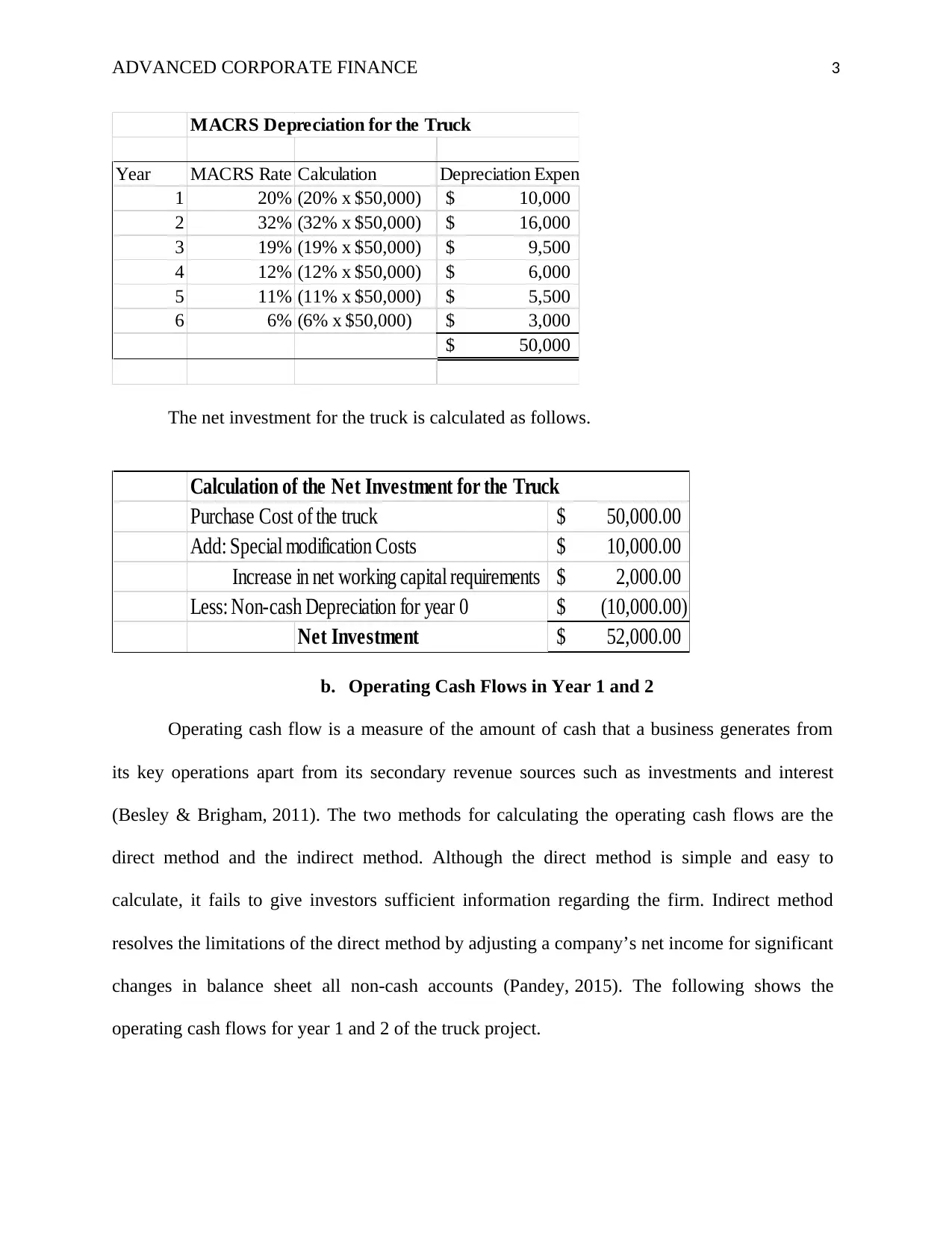
ADVANCED CORPORATE FINANCE 3
MACRS Depreciation for the Truck
Year MACRS Rate Calculation Depreciation Expense
1 20% (20% x $50,000) 10,000$
2 32% (32% x $50,000) 16,000$
3 19% (19% x $50,000) 9,500$
4 12% (12% x $50,000) 6,000$
5 11% (11% x $50,000) 5,500$
6 6% (6% x $50,000) 3,000$
50,000$
The net investment for the truck is calculated as follows.
Calculation of the Net Investment for the Truck
Purchase Cost of the truck 50,000.00$
Add: Special modification Costs 10,000.00$
Increase in net working capital requirements 2,000.00$
Less: Non-cash Depreciation for year 0 (10,000.00)$
Net Investment 52,000.00$
b. Operating Cash Flows in Year 1 and 2
Operating cash flow is a measure of the amount of cash that a business generates from
its key operations apart from its secondary revenue sources such as investments and interest
(Besley & Brigham, 2011). The two methods for calculating the operating cash flows are the
direct method and the indirect method. Although the direct method is simple and easy to
calculate, it fails to give investors sufficient information regarding the firm. Indirect method
resolves the limitations of the direct method by adjusting a company’s net income for significant
changes in balance sheet all non-cash accounts (Pandey, 2015). The following shows the
operating cash flows for year 1 and 2 of the truck project.
MACRS Depreciation for the Truck
Year MACRS Rate Calculation Depreciation Expense
1 20% (20% x $50,000) 10,000$
2 32% (32% x $50,000) 16,000$
3 19% (19% x $50,000) 9,500$
4 12% (12% x $50,000) 6,000$
5 11% (11% x $50,000) 5,500$
6 6% (6% x $50,000) 3,000$
50,000$
The net investment for the truck is calculated as follows.
Calculation of the Net Investment for the Truck
Purchase Cost of the truck 50,000.00$
Add: Special modification Costs 10,000.00$
Increase in net working capital requirements 2,000.00$
Less: Non-cash Depreciation for year 0 (10,000.00)$
Net Investment 52,000.00$
b. Operating Cash Flows in Year 1 and 2
Operating cash flow is a measure of the amount of cash that a business generates from
its key operations apart from its secondary revenue sources such as investments and interest
(Besley & Brigham, 2011). The two methods for calculating the operating cash flows are the
direct method and the indirect method. Although the direct method is simple and easy to
calculate, it fails to give investors sufficient information regarding the firm. Indirect method
resolves the limitations of the direct method by adjusting a company’s net income for significant
changes in balance sheet all non-cash accounts (Pandey, 2015). The following shows the
operating cash flows for year 1 and 2 of the truck project.
⊘ This is a preview!⊘
Do you want full access?
Subscribe today to unlock all pages.

Trusted by 1+ million students worldwide
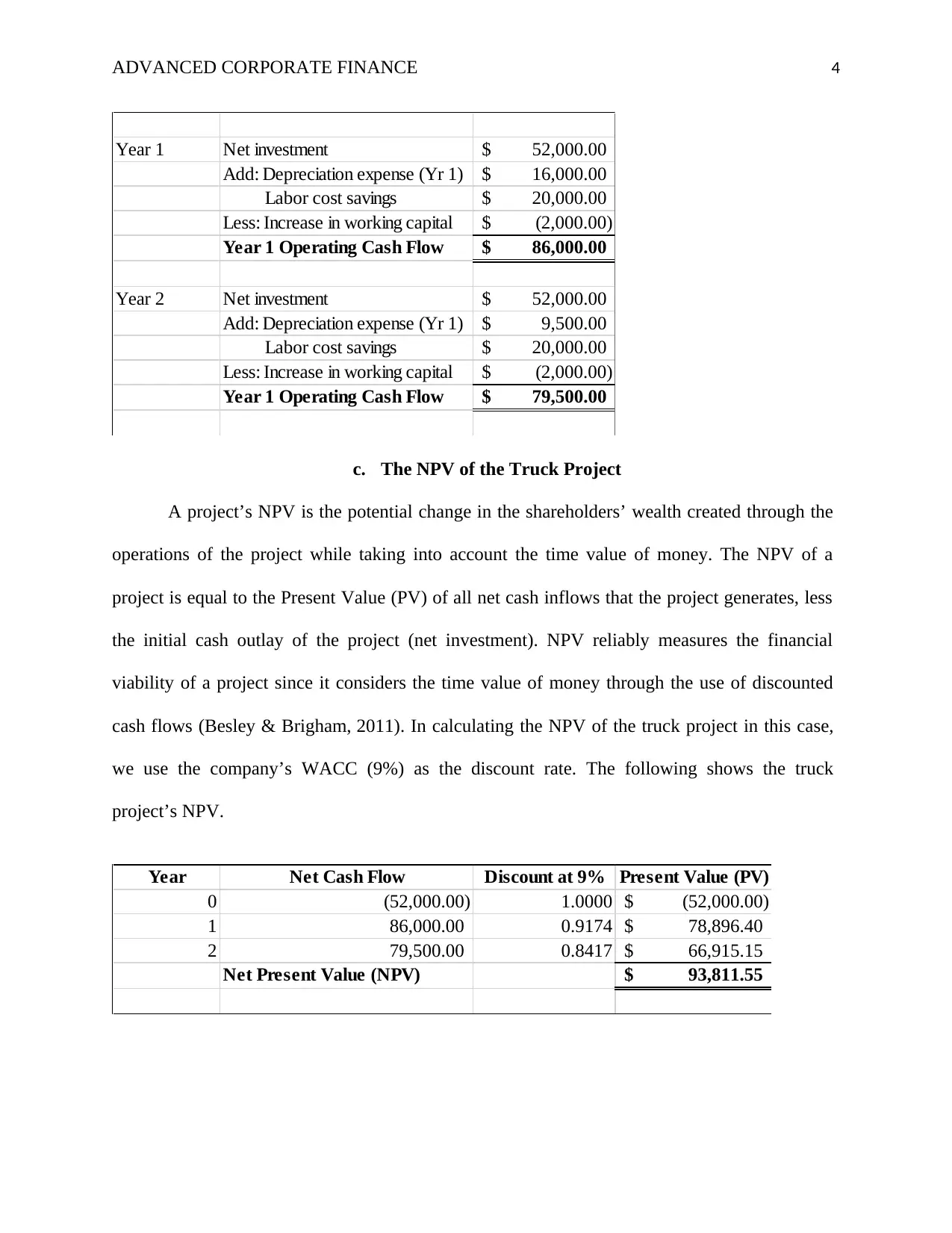
ADVANCED CORPORATE FINANCE 4
Year 1 Net investment 52,000.00$
Add: Depreciation expense (Yr 1) 16,000.00$
Labor cost savings 20,000.00$
Less: Increase in working capital (2,000.00)$
Year 1 Operating Cash Flow 86,000.00$
Year 2 Net investment 52,000.00$
Add: Depreciation expense (Yr 1) 9,500.00$
Labor cost savings 20,000.00$
Less: Increase in working capital (2,000.00)$
Year 1 Operating Cash Flow 79,500.00$
c. The NPV of the Truck Project
A project’s NPV is the potential change in the shareholders’ wealth created through the
operations of the project while taking into account the time value of money. The NPV of a
project is equal to the Present Value (PV) of all net cash inflows that the project generates, less
the initial cash outlay of the project (net investment). NPV reliably measures the financial
viability of a project since it considers the time value of money through the use of discounted
cash flows (Besley & Brigham, 2011). In calculating the NPV of the truck project in this case,
we use the company’s WACC (9%) as the discount rate. The following shows the truck
project’s NPV.
Year Net Cash Flow Discount at 9% Present Value (PV)
0 (52,000.00) 1.0000 (52,000.00)$
1 86,000.00 0.9174 78,896.40$
2 79,500.00 0.8417 66,915.15$
Net Present Value (NPV) 93,811.55$
Year 1 Net investment 52,000.00$
Add: Depreciation expense (Yr 1) 16,000.00$
Labor cost savings 20,000.00$
Less: Increase in working capital (2,000.00)$
Year 1 Operating Cash Flow 86,000.00$
Year 2 Net investment 52,000.00$
Add: Depreciation expense (Yr 1) 9,500.00$
Labor cost savings 20,000.00$
Less: Increase in working capital (2,000.00)$
Year 1 Operating Cash Flow 79,500.00$
c. The NPV of the Truck Project
A project’s NPV is the potential change in the shareholders’ wealth created through the
operations of the project while taking into account the time value of money. The NPV of a
project is equal to the Present Value (PV) of all net cash inflows that the project generates, less
the initial cash outlay of the project (net investment). NPV reliably measures the financial
viability of a project since it considers the time value of money through the use of discounted
cash flows (Besley & Brigham, 2011). In calculating the NPV of the truck project in this case,
we use the company’s WACC (9%) as the discount rate. The following shows the truck
project’s NPV.
Year Net Cash Flow Discount at 9% Present Value (PV)
0 (52,000.00) 1.0000 (52,000.00)$
1 86,000.00 0.9174 78,896.40$
2 79,500.00 0.8417 66,915.15$
Net Present Value (NPV) 93,811.55$
Paraphrase This Document
Need a fresh take? Get an instant paraphrase of this document with our AI Paraphraser
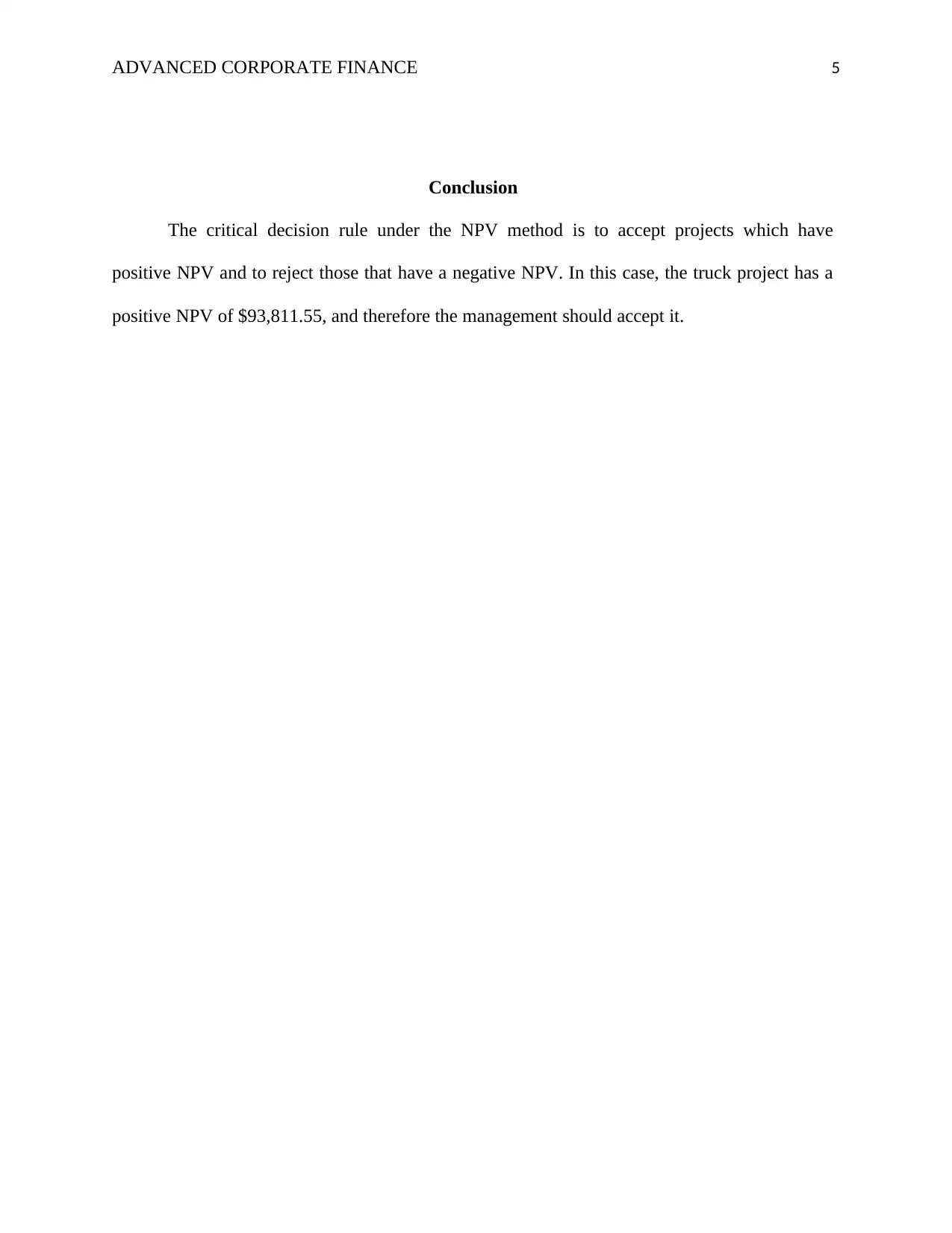
ADVANCED CORPORATE FINANCE 5
Conclusion
The critical decision rule under the NPV method is to accept projects which have
positive NPV and to reject those that have a negative NPV. In this case, the truck project has a
positive NPV of $93,811.55, and therefore the management should accept it.
Conclusion
The critical decision rule under the NPV method is to accept projects which have
positive NPV and to reject those that have a negative NPV. In this case, the truck project has a
positive NPV of $93,811.55, and therefore the management should accept it.
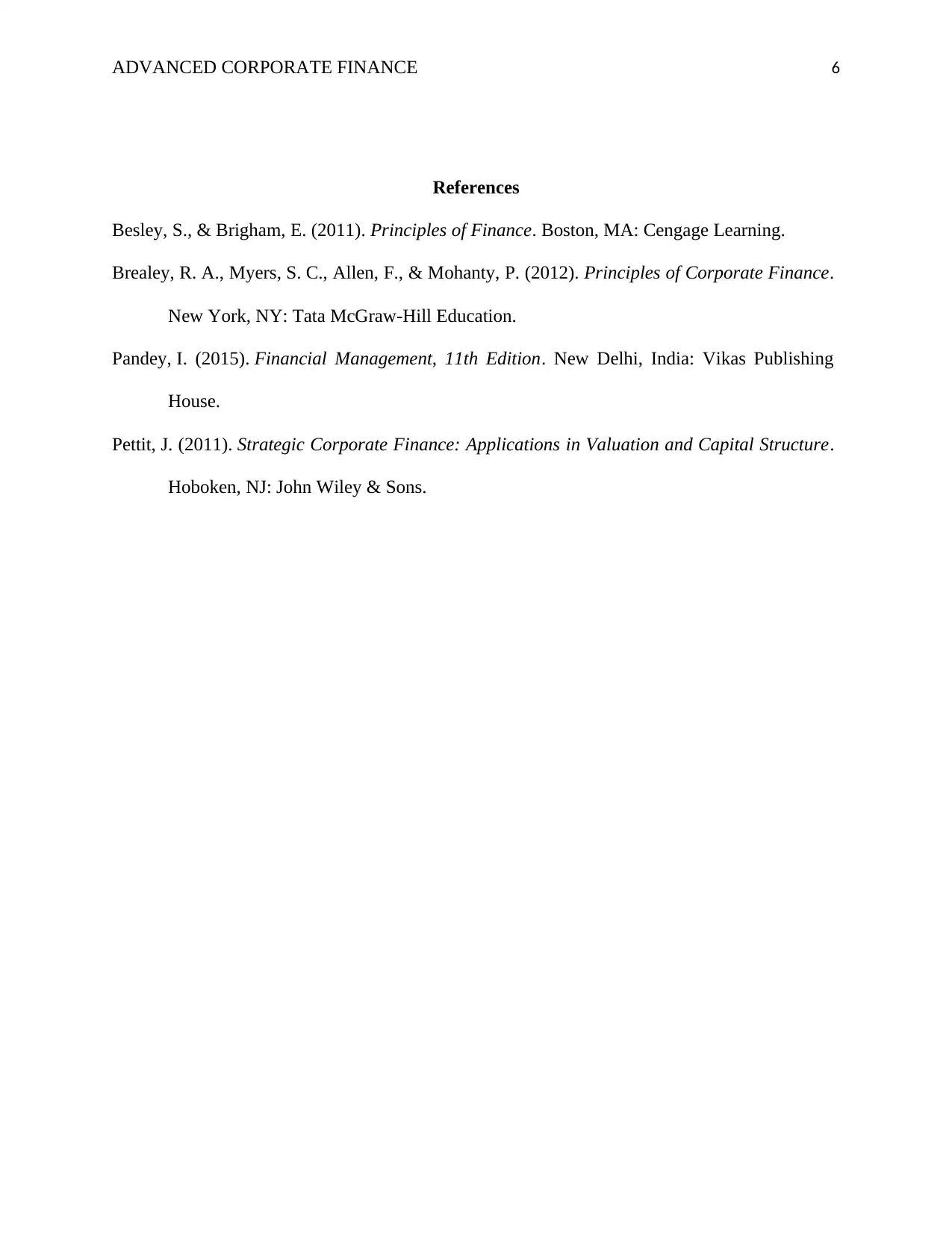
ADVANCED CORPORATE FINANCE 6
References
Besley, S., & Brigham, E. (2011). Principles of Finance. Boston, MA: Cengage Learning.
Brealey, R. A., Myers, S. C., Allen, F., & Mohanty, P. (2012). Principles of Corporate Finance.
New York, NY: Tata McGraw-Hill Education.
Pandey, I. (2015). Financial Management, 11th Edition. New Delhi, India: Vikas Publishing
House.
Pettit, J. (2011). Strategic Corporate Finance: Applications in Valuation and Capital Structure.
Hoboken, NJ: John Wiley & Sons.
References
Besley, S., & Brigham, E. (2011). Principles of Finance. Boston, MA: Cengage Learning.
Brealey, R. A., Myers, S. C., Allen, F., & Mohanty, P. (2012). Principles of Corporate Finance.
New York, NY: Tata McGraw-Hill Education.
Pandey, I. (2015). Financial Management, 11th Edition. New Delhi, India: Vikas Publishing
House.
Pettit, J. (2011). Strategic Corporate Finance: Applications in Valuation and Capital Structure.
Hoboken, NJ: John Wiley & Sons.
⊘ This is a preview!⊘
Do you want full access?
Subscribe today to unlock all pages.

Trusted by 1+ million students worldwide
1 out of 6
Related Documents
Your All-in-One AI-Powered Toolkit for Academic Success.
+13062052269
info@desklib.com
Available 24*7 on WhatsApp / Email
![[object Object]](/_next/static/media/star-bottom.7253800d.svg)
Unlock your academic potential
Copyright © 2020–2025 A2Z Services. All Rights Reserved. Developed and managed by ZUCOL.





